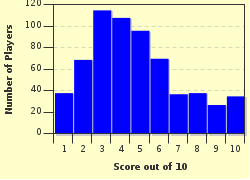Quiz Answer Key and Fun Facts
1. This city is one of the oldest in England, with a history stretching back over 2000 years. Its modern day name derives from a, possibly, Saxon name that meant 'camp of the Ligore'. Which modern city are we in?
2. In Anglo Saxon times this place was called Tig Guocobauc, which meant a 'place of cave dwellings'. At some point during the Saxon occupation the name changed to mean 'the home of the people of Snot'. Which city had this rather unpleasant name bestowed upon it?
3. This town is a comparative newcomer, indeed, in its present form it was designated as a New Town in 1948. It was made up of four villages, one of which gave it its current name. In 1086 it was recorded as Beorhtel's Hill. What is its modern name?
4. The original name of this relatively small town is of Celtic origin. It was known as Tre Ussig, the 'settlement by the water'. In The Doomsday Book it is recorded as Tresche, which derives from the Norse word bresk, which means 'marsh'. We are in Yorkshire, but where?
5. This town is on the east coast of England. Part of the name comes from the Celtic word for 'pool'. In its heyday, in the 14th century, it was England's third port. During the Reformation there was a major change in the name of this town, which is still the third largest in its county. Whereabouts, in the east of England, are we?
6. This town shares part of its name with several other towns across England. The second part comes from, probably, the Saxon term for 'valley with fields'. We are now in a part of central England known for its outstanding natural beauty. A small market town nestled within England's rolling countryside. Where are we?
7. This town got its present day name from the fact that it was originally built on the boundaries of two English Parishes. It does not feature in "The Doomsday Book", because the original Norman Castle wasn't built until 1080. The castle was built by Osmund, Bishop of Salisbury. This may give you a clue as to where we are.
8. This town is located in central southern England. The second part of the name comes from an old word for a wooded valley, and for the river that ran through it. Originally the name was applied to a much larger area than it is today. The first part of the name is a mystery, but it may stem from the towns wish to separate itself from the rest of the area. The area is famous for the Hellfire Club, although it is almost certain that they never held meetings within the modern town. Where are we?
9. The old name for this town meant 'market of Bearda'. Before the Norman invasion it had gained such importance that King Athelstan established a mint there. It was one of the most important towns in Devon at the time. What is it now called?
10. The original Roman name for the settlement where this city now stands was Portus Abonae. As usual after the Saxons took up residence the name changed, and by the time of the Norman invasion it was called Brycgstow. What do we know it as now?
Source: Author
romeomikegolf
This quiz was reviewed by FunTrivia editor
gtho4 before going online.
Any errors found in FunTrivia content are routinely corrected through our feedback system.

